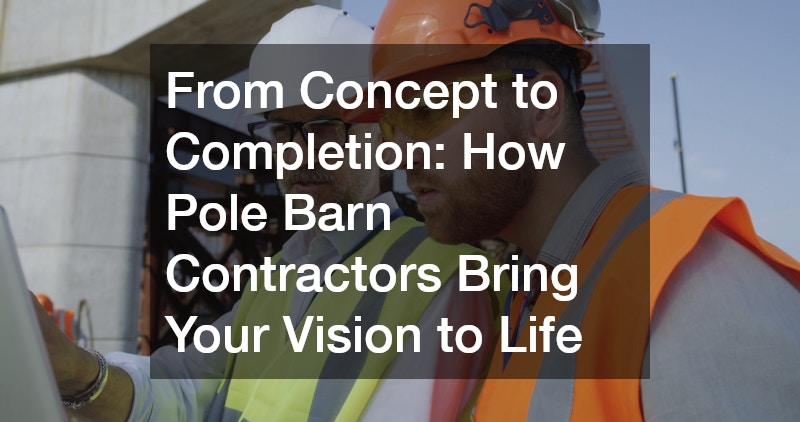Discover the journey of how pole barn contractors turn your initial vision into a fully realized structure. This article delves into the process, challenges, and artistry involved in making your dream pole barn a reality. The intricate translation from an idea to a physical building involves thorough planning, expert craftsmanship, and adherence to various guidelines and standards.
Whether it’s for agricultural storage, a new workspace, or a unique living space, pole barns have become a versatile solution for many needs. They present an opportunity to blend form and function seamlessly while catering to specific individual requirements. This article examines each step of the process, highlighting the skills and adaptability of pole barn contractors.
From the early stages of design and site preparation to the final construction details, the role of the contractor is crucial. Each phase demands careful consideration and expertise to ensure the outcome aligns with the client’s expectations. By examining these stages closely, we gain an appreciation for the complexities involved in creating a well-crafted pole barn.
Design and Planning
The initial phase of designing a pole barn is a collaborative effort between the contractor and the client. Contractors invest time in understanding the client’s vision and translating that into detailed plans that meet both aesthetic desires and functional needs. Compliance with zoning regulations and building codes is also a critical aspect of this stage, ensuring that all plans adhere to legal requirements.
Various software tools and drawing techniques are employed to visualize the proposed structure. These tools enable both the contractor and the client to foresee potential design issues and make necessary adjustments before any construction begins. Throughout this process, communication is key, ensuring that every aspect of the design aligns with the client’s ultimate goal.
Site Preparation
Site preparation is another critical step in the construction process, laying the groundwork for a stable and enduring structure. The first task involves evaluating the land and making necessary modifications to support the forthcoming build. Clearing debris, vegetation, and grading the terrain are essential elements of preparing the site for construction.
Leveling the land is particularly crucial for ensuring stability and durability. Contractors use specialized equipment to achieve a level surface, which is vital for preventing future structural issues. The foundational elements, such as posts and beams, rely heavily on the precision of the site grading.
Construction and Final Assembly
With the design finalized and the site prepared, construction can commence, starting with the skeletal framework. This phase involves erecting the main support structures, which are typically made from wood or steel, forming a durable backbone for the barn. Attention to detail during assembly is crucial to maintaining structural integrity and ensuring safety.
Once the framework is in place, contractors move on to installing the roof, walls, and any additional necessary components. Precision in this stage ensures that the barn is both weather-tight and aesthetically pleasing. The construction phase is where the client’s vision truly begins to take physical form, transitioning from theoretical to tangible.
Material Selection
Material selection is a pivotal aspect of building a pole barn, influencing both its durability and aesthetic value. Clients can choose from a variety of materials, such as steel, wood, and vinyl, each offering distinct benefits. The choice of materials impacts not just the barn’s appearance but also its longevity and maintenance needs.
Contractors guide clients through this decision-making process, offering insights into the advantages of each option. Steel, for example, offers remarkable strength and durability, while wood provides a classic, rustic look. The decision often depends on the intended use of the barn and the environmental conditions of the location.
Functional Layout Design
The interior layout of a pole barn is a crucial element that determines how well the space serves its intended function. Contractors work closely with clients to ensure that the layout maximizes usability and efficiency. This customization includes planning for storage areas, workspaces, and any other specialized sections required.
Designing a functional layout involves understanding the specific activities that will take place within the barn. Whether it’s for housing animals, storing equipment, or setting up a workshop, each requirement is carefully considered to optimize space use. Contractors often draw from experience and industry standards to propose layouts that enhance productivity.
Meeting Client Expectations
Aligning the final structure with client expectations is a sophisticated endeavor. Discrepancies between vision and reality can lead to dissatisfaction, making clear communication paramount from the outset. Contractors strive to articulate what is feasible within the given budget and guidelines, guiding the client through potential limitations or adjustments.
Summarizing the intricate process involved in taking a concept to completion, this article highlights the expertise and dedication of pole barn contractors in bringing personalized visions to life. The collaborative journey, from initial design to final construction, requires meticulous planning and adaptation to overcome various challenges. At every step, the contractor’s role is pivotal in ensuring that the final structure aligns with the client’s aspirations, both functionally and aesthetically.
Ultimately, the successful completion of a pole barn is a testament to effective collaboration and skilled craftsmanship. The process not only fulfills a practical need but also brings a unique vision to life, embodying creativity, precision, and resilience. Through their effort, contractors contribute to creating structures that stand the test of time and meet the diverse needs of their clients.
Discover the journey of how pole barn contractors turn your initial vision into a fully realized structure. This article delves into the process, challenges, and artistry involved in making your dream pole barn a reality. The intricate translation from an idea to a physical building involves thorough planning, expert craftsmanship, and adherence to various guidelines and standards.
Whether it’s for agricultural storage, a new workspace, or a unique living space, pole barns have become a versatile solution for many needs. They present an opportunity to blend form and function seamlessly while catering to specific individual requirements. This article examines each step of the process, highlighting the skills and adaptability of pole barn contractors.
From the early stages of design and site preparation to the final construction details, the role of the contractor is crucial. Each phase demands careful consideration and expertise to ensure the outcome aligns with the client’s expectations. By examining these stages closely, we gain an appreciation for the complexities involved in creating a well-crafted pole barn.
Design and Planning
The initial phase of designing a pole barn is a collaborative effort between the contractor and the client. Contractors invest time in understanding the client’s vision and translating that into detailed plans that meet both aesthetic desires and functional needs. Compliance with zoning regulations and building codes is also a critical aspect of this stage, ensuring that all plans adhere to legal requirements.
Various software tools and drawing techniques are employed to visualize the proposed structure. These tools enable both the contractor and the client to foresee potential design issues and make necessary adjustments before any construction begins. Throughout this process, communication is key, ensuring that every aspect of the design aligns with the client’s ultimate goal.
Site Preparation
Site preparation is another critical step in the construction process, laying the groundwork for a stable and enduring structure. The first task involves evaluating the land and making necessary modifications to support the forthcoming build. Clearing debris, vegetation, and grading the terrain are essential elements of preparing the site for construction.
Leveling the land is particularly crucial for ensuring stability and durability. Contractors use specialized equipment to achieve a level surface, which is vital for preventing future structural issues. The foundational elements, such as posts and beams, rely heavily on the precision of the site grading.
Construction and Final Assembly
With the design finalized and the site prepared, construction can commence, starting with the skeletal framework. This phase involves erecting the main support structures, which are typically made from wood or steel, forming a durable backbone for the barn. Attention to detail during assembly is crucial to maintaining structural integrity and ensuring safety.
Once the framework is in place, contractors move on to installing the roof, walls, and any additional necessary components. Precision in this stage ensures that the barn is both weather-tight and aesthetically pleasing. The construction phase is where the client’s vision truly begins to take physical form, transitioning from theoretical to tangible.
Material Selection
Material selection is a pivotal aspect of building a pole barn, influencing both its durability and aesthetic value. Clients can choose from a variety of materials, such as steel, wood, and vinyl, each offering distinct benefits. The choice of materials impacts not just the barn’s appearance but also its longevity and maintenance needs.
Contractors guide clients through this decision-making process, offering insights into the advantages of each option. Steel, for example, offers remarkable strength and durability, while wood provides a classic, rustic look. The decision often depends on the intended use of the barn and the environmental conditions of the location.
Functional Layout Design
The interior layout of a pole barn is a crucial element that determines how well the space serves its intended function. Contractors work closely with clients to ensure that the layout maximizes usability and efficiency. This customization includes planning for storage areas, workspaces, and any other specialized sections required.
Designing a functional layout involves understanding the specific activities that will take place within the barn. Whether it’s for housing animals, storing equipment, or setting up a workshop, each requirement is carefully considered to optimize space use. Contractors often draw from experience and industry standards to propose layouts that enhance productivity.
Meeting Client Expectations
Aligning the final structure with client expectations is a sophisticated endeavor. Discrepancies between vision and reality can lead to dissatisfaction, making clear communication paramount from the outset. Contractors strive to articulate what is feasible within the given budget and guidelines, guiding the client through potential limitations or adjustments.
Summarizing the intricate process involved in taking a concept to completion, this article highlights the expertise and dedication of pole barn contractors in bringing personalized visions to life. The collaborative journey, from initial design to final construction, requires meticulous planning and adaptation to overcome various challenges. At every step, the contractor’s role is pivotal in ensuring that the final structure aligns with the client’s aspirations, both functionally and aesthetically.
Ultimately, the successful completion of a pole barn is a testament to effective collaboration and skilled craftsmanship. The process not only fulfills a practical need but also brings a unique vision to life, embodying creativity, precision, and resilience. Through their effort, contractors contribute to creating structures that stand the test of time and meet the diverse needs of their clients.


